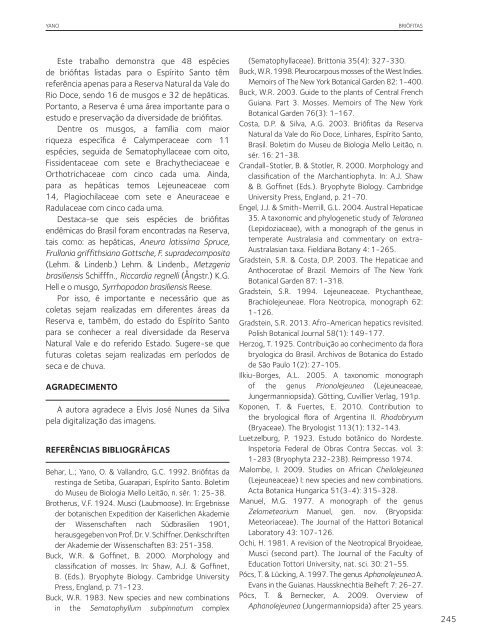RESERVA NATURAL VALE
livrofloresta
livrofloresta
Create successful ePaper yourself
Turn your PDF publications into a flip-book with our unique Google optimized e-Paper software.
YANO<br />
BRIÓFITAS<br />
Este trabalho demonstra que 48 espécies<br />
de briófitas listadas para o Espírito Santo têm<br />
referência apenas para a Reserva Natural da Vale do<br />
Rio Doce, sendo 16 de musgos e 32 de hepáticas.<br />
Portanto, a Reserva é uma área importante para o<br />
estudo e preservação da diversidade de briófitas.<br />
Dentre os musgos, a família com maior<br />
riqueza específica é Calymperaceae com 11<br />
espécies, seguida de Sematophyllaceae com oito,<br />
Fissidentaceae com sete e Brachytheciaceae e<br />
Orthotrichaceae com cinco cada uma. Ainda,<br />
para as hepáticas temos Lejeuneaceae com<br />
14, Plagiochilaceae com sete e Aneuraceae e<br />
Radulaceae com cinco cada uma.<br />
Destaca-se que seis espécies de briófitas<br />
endêmicas do Brasil foram encontradas na Reserva,<br />
tais como: as hepáticas, Aneura latissima Spruce,<br />
Frullania griffithsiana Gottsche, F. supradecomposita<br />
(Lehm. & Lindenb.) Lehm. & Lindenb., Metzgeria<br />
brasiliensis Schifffn., Riccardia regnelli (Ångstr.) K.G.<br />
Hell e o musgo, Syrrhopodon brasiliensis Reese.<br />
Por isso, é importante e necessário que as<br />
coletas sejam realizadas em diferentes áreas da<br />
Reserva e, também, do estado do Espírito Santo<br />
para se conhecer a real diversidade da Reserva<br />
Natural Vale e do referido Estado. Sugere-se que<br />
futuras coletas sejam realizadas em períodos de<br />
seca e de chuva.<br />
AGRADECIMENTO<br />
A autora agradece a Elvis José Nunes da Silva<br />
pela digitalização das imagens.<br />
REFERÊNCIAS BIBLIOGRÁFICAS<br />
Behar, L.; Yano, O. & Vallandro, G.C. 1992. Briófitas da<br />
restinga de Setiba, Guarapari, Espírito Santo. Boletim<br />
do Museu de Biologia Mello Leitão, n. sér. 1: 25-38.<br />
Brotherus, V.F. 1924. Musci (Laubmoose). In: Ergebnisse<br />
der botanischen Expedition der Kaiserlichen Akademie<br />
der Wissenschaften nach Südbrasilien 1901,<br />
herausgegeben von Prof. Dr. V. Schiffner. Denkschriften<br />
der Akademie der Wissenschaften 83: 251-358.<br />
Buck, W.R. & Goffinet, B. 2000. Morphology and<br />
classification of mosses. In: Shaw, A.J. & Goffinet,<br />
B. (Eds.). Bryophyte Biology. Cambridge University<br />
Press, England, p. 71-123.<br />
Buck, W.R. 1983. New species and new combinations<br />
in the Sematophyllum subpinnatum complex<br />
(Sematophyllaceae). Brittonia 35(4): 327-330.<br />
Buck, W.R. 1998. Pleurocarpous mosses of the West Indies.<br />
Memoirs of The New York Botanical Garden 82: 1-400.<br />
Buck, W.R. 2003. Guide to the plants of Central French<br />
Guiana. Part 3. Mosses. Memoirs of The New York<br />
Botanical Garden 76(3): 1-167.<br />
Costa, D.P. & Silva, A.G. 2003. Briófitas da Reserva<br />
Natural da Vale do Rio Doce, Linhares, Espírito Santo,<br />
Brasil. Boletim do Museu de Biologia Mello Leitão, n.<br />
sér. 16: 21-38.<br />
Crandall-Stotler, B. & Stotler, R. 2000. Morphology and<br />
classification of the Marchantiophyta. In: A.J. Shaw<br />
& B. Goffinet (Eds.). Bryophyte Biology. Cambridge<br />
University Press, England, p. 21-70.<br />
Engel, J.J. & Smith-Merrill, G.L. 2004. Austral Hepaticae<br />
35. A taxonomic and phylogenetic study of Telaranea<br />
(Lepidoziaceae), with a monograph of the genus in<br />
temperate Australasia and commentary on extra-<br />
Australasian taxa. Fieldiana Botany 4: 1-265.<br />
Gradstein, S.R. & Costa, D.P. 2003. The Hepaticae and<br />
Anthocerotae of Brazil. Memoirs of The New York<br />
Botanical Garden 87: 1-318.<br />
Gradstein, S.R. 1994. Lejeuneaceae. Ptychantheae,<br />
Brachiolejeuneae. Flora Neotropica, monograph 62:<br />
1-126.<br />
Gradstein, S.R. 2013. Afro-American hepatics revisited.<br />
Polish Botanical Journal 58(1): 149-177.<br />
Herzog, T. 1925. Contribuição ao conhecimento da flora<br />
bryologica do Brasil. Archivos de Botanica do Estado<br />
de São Paulo 1(2): 27-105.<br />
Ilkiu-Borges, A.L. 2005. A taxonomic monograph<br />
of the genus Prionolejeunea (Lejeuneaceae,<br />
Jungermanniopsida). Götting, Cuvillier Verlag, 191p.<br />
Koponen, T. & Fuertes, E. 2010. Contribution to<br />
the bryological flora of Argentina II. Rhodobryum<br />
(Bryaceae). The Bryologist 113(1): 132-143.<br />
Luetzelburg, P. 1923. Estudo botânico do Nordeste.<br />
Inspetoria Federal de Obras Contra Seccas. vol. 3:<br />
1-283 (Bryophyta 232-238). Reimpresso 1974.<br />
Malombe, I. 2009. Studies on African Cheilolejeunea<br />
(Lejeuneaceae) I: new species and new combinations.<br />
Acta Botanica Hungarica 51(3-4): 315-328.<br />
Manuel, M.G. 1977. A monograph of the genus<br />
Zelometeorium Manuel, gen. nov. (Bryopsida:<br />
Meteoriaceae). The Journal of the Hattori Botanical<br />
Laboratory 43: 107-126.<br />
Ochi, H. 1981. A revision of the Neotropical Bryoideae,<br />
Musci (second part). The Journal of the Faculty of<br />
Education Tottori University, nat. sci. 30: 21-55.<br />
Pócs, T. & Lücking, A. 1997. The genus Aphanolejeunea A.<br />
Evans in the Guianas. Haussknechtia Beiheft 7: 26-27.<br />
Pócs, T. & Bernecker, A. 2009. Overview of<br />
Aphanolejeunea (Jungermanniopsida) after 25 years.<br />
2 4 5


